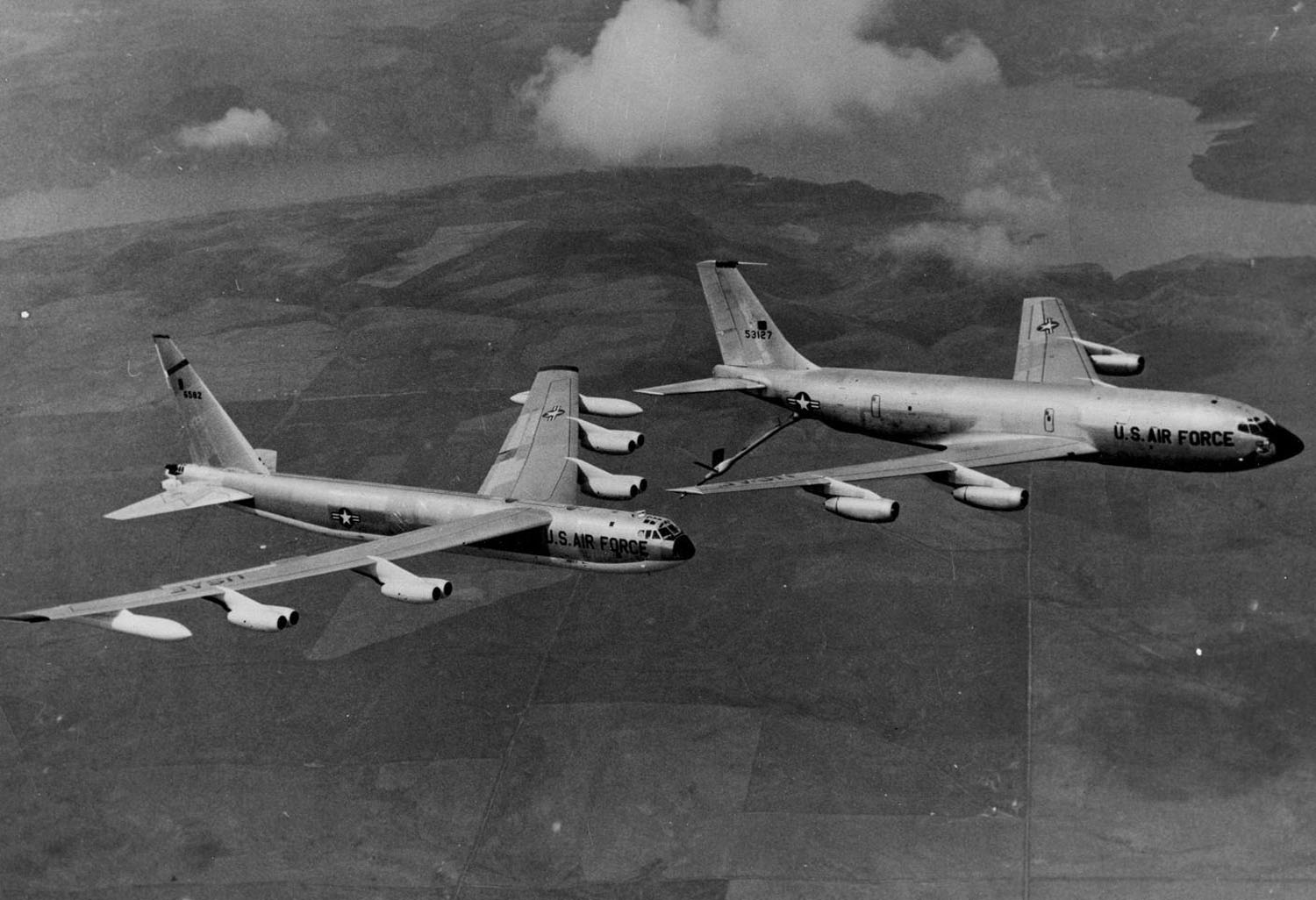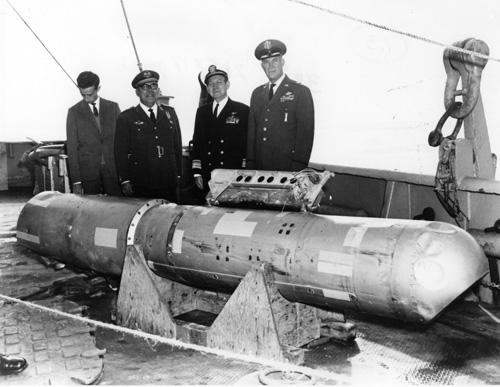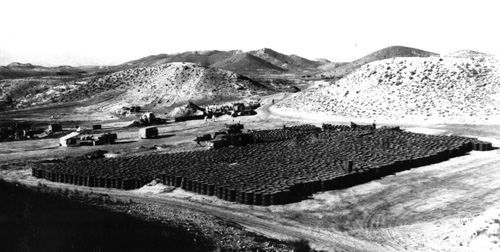|
|
Next Page
Go Direct to Ops Summaries and Prop Wash Page (1),
(2),
(3),
(4),
(5),
(6),
(7),
(8)
(9)
(10)
(11)
(12),
(13)
(14),
(15),
(16),
(17),
(18),
(19),
(20),
(21),
(22),
(23),
(24),
(25),
(27),
(28),
(29),
(30),
(31),
(32),
(33),
(34),
(35),
(36),
(37),
(38),
Return to
Scrapbook Page One
Return to Home
Page
Anyone who served in the U.S. military during the Cold War likely heard the term,
Broken Arrow. However, many who heard it probably did not know what it meant, until years
later when a spate of action and suspense thrillers revealing pseudo secrets of military
intelligence, espionage, and intrigue publicized its meaning.
For those who still may not be familiar with the term, Broken Arrow, a DOD document defines it thus:
"A Chairman of the Joint Chiefs of Staff term to identify and report an accident involving a
nuclear weapon or warhead or nuclear component." (Broken Arrow is the worst case scenario.).
The U.S. Navy is more explicit: The accidental or unauthorized detonation, or possible detonation
of a nuclear weapon (other than war risk) including the non-nuclear detonation or burning of a
nuclear weapon; radioactive contamination; or seizure, theft, or loss of a nuclear weapon or
component (including jettisoning).
VR-24 flight crews rarely had any reason to be concerned about such matters, given the extremely
tight security and restrictions on transporting nuclear weapons by aircraft other than those intended
to deliver them onto a target. One of the rare occasions when they did began with a telephone call
to LT Barb Kelly’s apartment in Naples one evening in January 1966. A party was in progress attended
by a number of the squadron pilots and their wives. The message was reportedly brief; several of
the pilots were to report back to the squadron immediately to fly a mission. The code word
Broken Arrow may have been used to expedite compliance but if so, recollection of it has faded
with passage of time. The event that precipitated the recall, however, would become world-wide news,
and not be forgotten anytime soon. It was, and still is, considered by many as the most serious nuclear
weapons accident on record, at least among those that have happened to U.S. armed forces. No other
such accident has resulted in as extensive and expensive recovery and clean-up effort.
On 17 January 1966, a B-52 was on the return leg of a routine training mission back to its
home base in North Carolina. Its mission profile called for a third refueling over the Mediterranean
from a KC-135 tanker based at Moron AFB near Seville, Spain. The refueling attempt went awry,
possibly due to the B-52 under-running the tanker. It was thought that the fueling boom ripped open
the bomber’s fuselage causing the B-52 to break up in flight. The tanker’s load of jet fuel exploded,
killing its four man crew. Four of the seven-man B-52 crew parachuted safely.
|
 (USAF photo)
This photo depicts a B-52D, lower left,
and a KC-135, upper right, like those involved in the Broken Arrow event over Palomares, Spain
on 17 January 1966. The KC-135's refueling boom is visible extending from under the tanker's tail.
|
Flaming wreckage from both aircraft rained down from 30,000 feet, along with four unarmed
MK-38 nuclear weapons that had been in the B-52’s bomb bays. Debris was scattered over
an area covering 100 square miles along the coast of Spain around, and off shore from Palomares,
a fishing village located about half way between Cartegena and Cabo de Gata, at the southeast
corner of the Iberian Peninsular.
Three of the four unarmed nuclear weapons fell on land where the high explosives in two of them detonated.
The fourth weapon fell five miles offshore into 2800 feet of water. Thus began major efforts to find and recover
the weapon from the ocean, and clean up and decontaminate about five hundred acreas of land around the village of Palomares.
A parallel effort was undertaken by the U.S. Ambassador to Spain to contain the political fallout of
what quickly became a diplomatic nightmare, fueled in no small part by Soviet Cold War propaganda.
|

(USAF photo) |
One of three unarmed Hydrogen bombs that fell from a
B-52 after a mid-air with a KC-135 near Palomares, Spain. Its retardation parachute, visible in
this photo, no doubt prevented the weapon's high explosive from detonating, as did that in the
other two weapons that fell on land following the mid-air. Also visible in the bottom of the photo is
damage to the nose of the weapon. |
Among the first actions taken by the SOPA (Senior Officer Present Afloat) aboard the USS Boston as soon as
he arrived off Palomares was to request airlift of personnel and equipment to assist in finding the two
unexploded weapons, and secure aircraft wreckage. Help would also be needed to identify areas contaminated
by plutonium scattered by the high explosive charges from the two weapons that had detonated. It was this
urgent request that caused the late-evening telephone call to LT Kelly’s apartment.
For reasons now unclear, NALCOEMREP (Naval Air Logistics Coordination Office Europe Mediterranean
Representative), who issued mission tasking to VR-24, was unable, on such short notice, to fulfill the
request by SOPA Palomares to provide a body to ride the ship and
act as on-scene air logistics coordinator. In its typical ‘can-do’ spirit, VR-24 Det Naples responded by
assigning LTJG Steve Cobe to the job until NALCO could make other arrangements. A C1A was airborne in
the early morning hours, heading west across the Med with LTJG Cobe, and a high-priority load of
supplies on board.
Perhaps ignorant of who or what NALCOEMREP was, the folks responsible for the care and feeding of his
agent took no chances. LTJG Cobe received VIP treatment on the BOSTON. He was met at the gangway
by a young officer, who though apparently mystified as to why a junior officer like himself should be
given such a welcome, ushered Steve to a single stateroom in the senior officers’ area of the ship.
Unsure what his role was to be, Steve was just as mystified by the ‘special treatment’ he got from
everyone onboard.
Over the next several days, however, things sorted themselves out. LTJG Cobe took input from the
BOSTON’s Supply Officer and generated messages in the form of airlift requests, which when released by
the ship’s CO were forwarded to Naples. There they were filled by Supply and became the basis of tasking
for VR-24. And as might be expected, when more senior representatives of other organizations involved in
the massive recovery and cleanup effort came aboard, Steve Cobe was evicted from his single stateroom.
He spent the majority of his month long tour aboard the BOSTON sharing berthing space in the J.O. jungle.
It is unknown if Steve was relieved by anyone else representing NALCOEMREP, but it is doubtful anyone after
him received the welcome he did.
|

(USN photo cobe collection) |
The USS Boston CAG1 off
Palomares, Spain, 1966. VR-24 Det Naples pilot, LTJG Steve Cobe spent a month
on the BOSTON acting as Air Logistics Coordinator for NALCOEMREP, Naples. |
The impact points of the two weapons whose HE detonated, and the third weapon that also fell on land without
exploding, were located in a matter of hours. Finding the fourth weapon submerged in 2800 feet of water took longer.
The search and recovery of that weapon involved about 3,000 U.S. Navy personnel, 33 ships, and uncounted other
ships and aircraft, including those of VR-24, that moved personnel, equipment and supplies into the area.
The lost weapon was found about eighty days after the accident by the USS Petral using the deep submersible, ALVIN.
The weapon was subsequently displayed for the international press onboard the USS Albany, at the
insistence of the media-savvy U.S. Ambassador to Spain, Angier Biddle Duke, in an effort to reduce the
political fallout of the accident.
|
 (USN photo)
From left to right are Sr. Don Antonio Velilla Manteca,
chief of the Spanish Nuclear Energy Board in Palomares; Brigadier General Arturo Montel Touzet,
Spanish coordinator for the search and recovery operation; Rear Admiral William S. Guest,
commander of U.S. Navy Task Force 65; and Major General Delmar E. Wilson, commander of the
Sixteenth Air Force. It is unclear whether this photo was taken on USS Petrel, the recovery
vessel, or the USS Albany, RADM Guest's flagship.
|
| Over a three month period, concurrent with the
undersea search for the fourth weapon, a massive cleanup of radioactive material was performed.
That effort by 1600 U.S. Air Force personnel resulted in 1,450 tons, or 1,750 tons
(depending on the selected reference) of contaminated dirt and vegetation from around
Palomares. The adjacent photo shows 55-gallon drums containing contaminated material awaiting
shipment to the U.S. for storage in a nuclear dump near Aiken SC. |

(USAF photo) |
On the lighter side, if there was one to this tragedy, the resourcefulness of one Spaniard named
Francisco Simo Orts is worth noting. Senor Orts was one of at least two local fishermen who reported
sighting the weapon’s parachute as it entered the water about five miles off shore. Being a good
citizen, he contracted with the U.S. Air Force to assist in the search for the weapon. With that
assistance, and a little extra by a team of mathematicians from Wagner Associates using a grid search
based on Bayesian search theory, the weapon was finally located.
Senor Orts might have been happy with nominal recompense and an official acknowledgment of his
assistance at that point had U.S. SECDEF, Robert McNamara not previously seen fit to publicly announce that the
lost weapon was worth two billion U.S. dollars. Senor Orts still might have let it go, had it not been
for the, ah, assistance, a much less provocative word than persuasion, of a lawyer named Herbert
Brownell, who happened to be former U.S. Attorney General under President Eisenhower. How Francisco Orts,
presumably a simple Spanish fisherman, got hooked up with Mr. Brownell is anybody’s guess. What is
known, however, is that the two showed up at the Federal Court house in New York City claiming salvage
rights.
Francisco Orts, or his very able attorney, knew his maritime law, which states that the person who
identifies the location of a ship to be salvaged has the right to a salvage award if that
identification leads to a successful recovery. The amount is usually 1 or 2 percent, sometimes a bit
more, of the intrinsic value to the owner of the thing salvaged. By no less an authority than Secretary
of Defense McNamara the weapon lost and recovered was valued at $2 billion. That translated to
between $20 and $40 million dollars! The Air Force settled out of court.
By 1969, a U.S.Commission had settled 522 claims by Palomares residents totalling $600,000. It is not
known if Senor Ots’ settlement was included in this amount. The town of Palomares was also given a
desalting plant, which cost about $200,000 to build.
VR-24’s role, besides that of LTJG Steve Cobe, in the aftermath of this Broken Arrow is not precisely
known. Undoubtedly, a much greater than normal number of logistics flights went to Cartegena, Spain,
the nearest Spanish military airfield, during the three month period following the accident. Aside
from the urgent nature of the effort supported, those flights were for the flight crews of VR-24 all
in a day’s work.
Top of Page
Next Page
Go Direct to Ops Summaries and Prop Wash Page (1),
(2),
(3),
(4),
(5),
(6),
(7),
(8)
(9)
(10)
(11)
(12),
(13)
(14),
(15),
(16),
(17),
(18),
(19),
(20),
(21),
(22),
(23),
(24),
(25),
(27),
(28),
(29),
(30),
(31),
(32),
(33),
(34),
(35),
(36),
(37),
(38),
Return to
Scrapbook Page One
Return to Home
Page
Copyright © 2002 VR-24
Association


